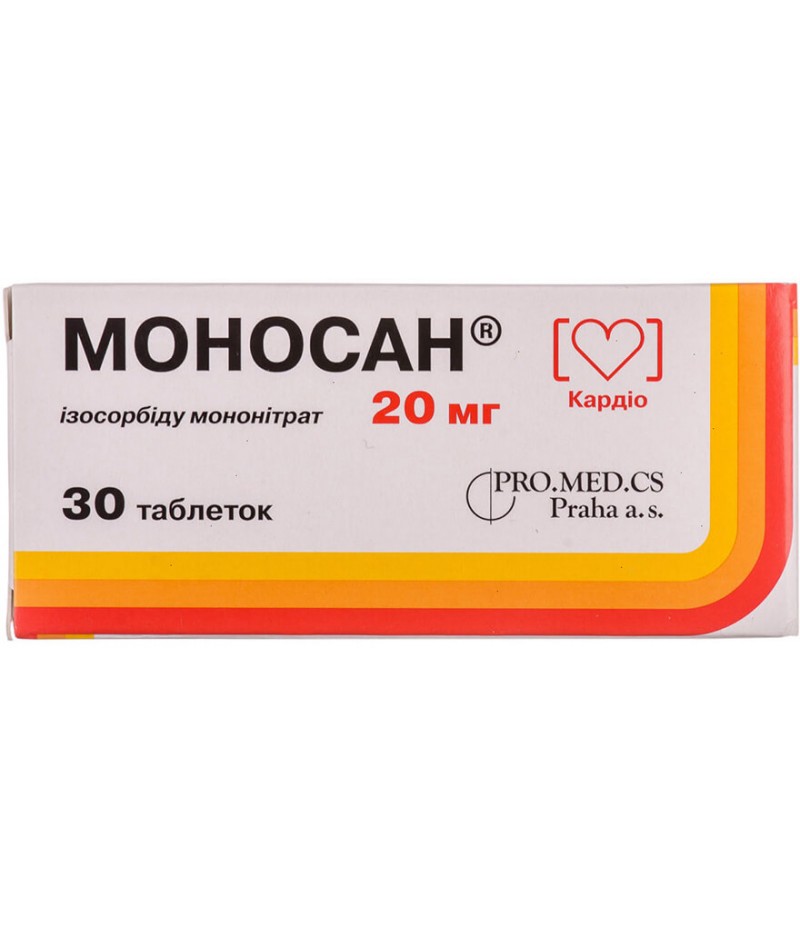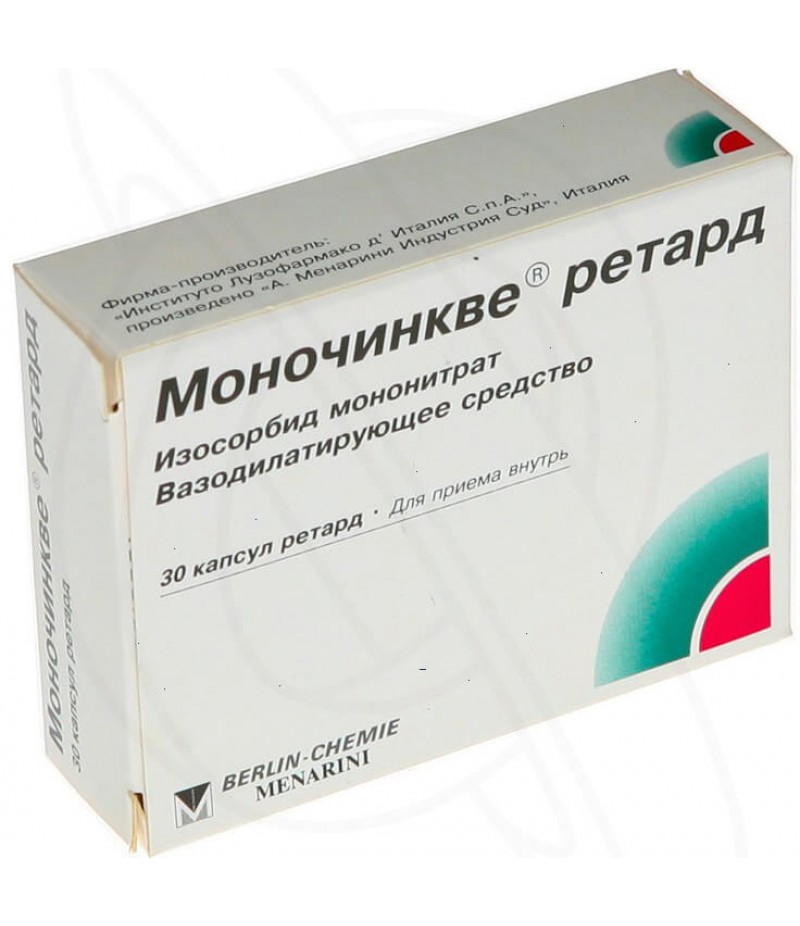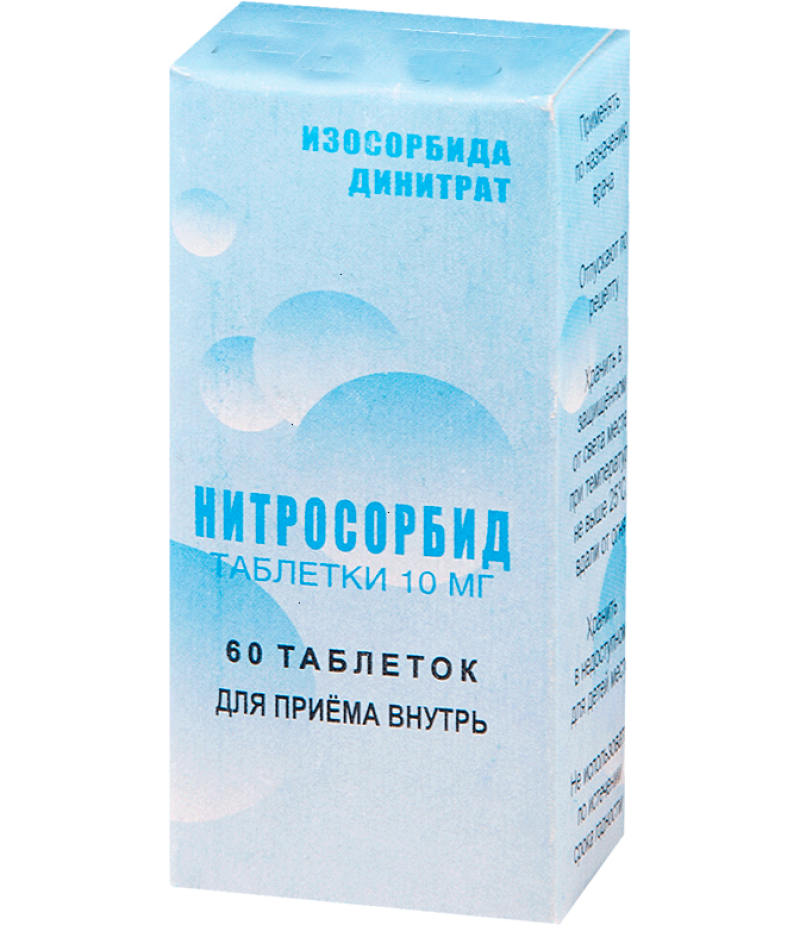Monosan tabs 20mg #30
- $4.85
- 3 or more $4.79
- Availability:In Stock
Monosan instruction for useYou can buy Monosan hereCompositionThe tablet contains 20/40 mg of the active substance isosorbide-5-mononitrate.Auxiliary components: granulated lactose, microcrystalline cellulose, starch (maize), talc..
Tags: tabs
Monosan instruction for use
You can buy Monosan here
Composition
The tablet contains 20/40 mg of the active substance isosorbide-5-mononitrate.
Auxiliary components: granulated lactose, microcrystalline cellulose, starch (maize), talc and magnesium stearate.
Release form
Monosan is produced by the manufacturer in tablet form. White tablets have a rounded shape, a special risk is visualized on one side.
Tablets packed in 10 pieces in blisters. In a cardboard box there are 3 blisters with pills and instructions with recommendations.
pharmachologic effect
The active component is a peripheral vasodilator ("vazo" - vessels + "dilator" - expander), which affects mainly venous vessels. Monosan is able to stimulate the production of a special relaxing endothelial factor - nitric oxide in the vascular endothelium.
Under the influence of this factor, the intracellular enzyme guanylate cyclase is activated, which leads to an increase in the vasodilating mediator - cGMP.
As a result, the need for myocardial cells in O2 decreases, which is explained by a decrease in afterload and preload. Registered coronary expanding effect.
The active substance is able to reduce blood flow to the right atrium, reducing pressure in the pulmonary circulation and reducing the severity of negative symptoms in pulmonary edema. In areas with reduced blood circulation, there is a redistribution of coronary blood flow under the influence of Monosan.
In patients who suffer from angina pectoris, ischemic heart disease markedly increases tolerance (resistance) to physical exertion. Often, on the background of the use of nitrates, headaches appear, which is explained by the ability of medicines to expand the lumen of the vessels of the dura mater and the brain.
Monosan is able to reduce the rate of intra platelet synthesis of Th, as well as inhibit platelet aggregation. Characteristic of cross tolerance. Sensitivity to the active substance after a break in treatment is restored fairly quickly.
Pharmacodynamics and pharmacokinetics
After taking a per os antianginal effect is recorded after 30-45 minutes and can last almost 10 hours. The active ingredient is rapidly and completely absorbed from the lumen of the digestive tract. Isosorbide mononitrate has a high bioavailability index of 100%, which is explained by the absence of the effect of the first passage through the hepatic system.
T max after taking is 1 hour. Plasma concentration varies only slightly depending on individual differences. The indicator of the individual level of the active substance in the blood plasma is 100 mg / ml. Binding to plasma proteins does not occur. For pharmacokinetics in dosages from 10 to 80 mg, linearity is characteristic.
The metabolism of the active substance is carried out in the renal system, in contrast to Isosorbide dinitrate, which is metabolized in the hepatic system. As a result of metabolic reactions, 3 components are formed: 2 isosorbide-5-mononitrate glucuronide and isosorbide. The half-life is 4-5 hours. 2% is excreted unchanged through the renal system, 98% as glucuronic metabolites. Renal clearance is 115 ml / min. Pharmacokinetics of the drug does not change significantly with renal and hepatocellular insufficiency.
Indications for use Monosan
The drug can be used both in monotherapy and as part of a multi-component treatment regimen. Monosan application in cardiology:
pulmonary heart, pulmonary hypertension;
chronic heart failure;
prevention of angina attacks in patients with coronary artery disease.
Contraindications
vascular collapse;
shock;
arterial hypovolemia and hypotension (decrease in systolic blood pressure to 100 mm Hg; drop in diastolic blood pressure below 60 mm Hg; decrease in venous central pressure to 4–5 mm Hg);
heart tamponade;
acute stage of myocardial infarction (with severe hypotension);
left ventricular failure and low diastolic blood pressure;
toxic pulmonary edema;
breast-feeding;
angle-closure glaucoma;
diseases provoking the rise of intracranial pressure (traumatic brain injury, hemorrhagic stroke and others);
individual hypersensitivity;
age limit - to maturity.
Relative contraindications:
constrictive pericarditis;
tendency to orthostatic disorders of vascular regulation;
mitral stenosis;
elderly age;
severe renal failure;
liver failure (the risk of developing methemoglobinemia increases);
hypertrophic cardiomyopathy (increased angina attacks);
thyrotoxicosis;
severe anemia;
aortic stenosis.
Side effects of Monosan
Digestive tract:
burning sensation in the tongue;
vomiting;
feeling of dry mouth;
nausea.
The cardiovascular system:
tachycardia;
feeling hot in the body;
hyperemia of the skin;
nitrate headaches;
marked drop in blood pressure;
dizziness;
orthostatic collapse;
increased and increased angina attacks (a kind of paradoxical reaction).
Nervous system:
slowing the speed of motor and mental reactions;
increased sleepiness;
stiffness;
blurred visual perception.
Other reactions:
establishment of tolerance (the cross form - in relation to other nitrates);
exfoliative dermatitis;
specific skin rashes.
Monosan, instructions for use (method and dosage)
Tablets are used only per os. The manufacturer recommends to drink the tablets with water, swallowing it whole. Assessing the severity of the underlying disease and comorbidities, the treating doctor selects the treatment regimen.
Treatment begins with the reception of 10-20 mg Monosan 1-3 times a day. From 3-4 days of treatment, the dosage regimen is adjusted depending on the clinical effect, possibly increasing to 20-40 mg twice a day. In some cases, the amount of the drug is increased to 80 mg / day - the maximum daily dosage.
Overdose
Fainting, collapse, dizziness, redness of skin, dyspnea, hyperpnoea, infants, diarrhea syndrome, headaches, lethargy, weakness, tachycardia reflex origin, pyrexia, visual disturbances, paralysis, increased intracranial pressure, convulsions, coma, vomiting, nausea, increased sweating.
General recommendations: give the patient a horizontal position, carry out manipulations on gastric lavage, prescribe enterosorbing drugs, monitor indicators of vital functions, and correct them if necessary.
Specific therapy: in shock and severe arterial hypotension, the BCC is replenished. Dopamine and / or Norepinephrine infusion is carried out in exceptional cases to improve blood circulation.
Adrenaline, Epinephrine and other related compounds are not allowed. When diagnosing methemoglobinemia, hemodialysis, oxygen therapy, exchange transfusion are performed, ascorbic acid is administered intravenously in the form of sodium salt.
Interaction
The active substance can increase the concentration of dihydroergotamine in the blood. A decrease in the effectiveness of vasopressor drugs has been reported. Barbiturates are able to reduce the concentration of isosorbide and accelerate its biological transformation.
The potentiation of the hypotensive effect of isosorbide mononitrate is registered with simultaneous treatment with Tadalafil, tricyclic antidepressants, neuroleptics, Vardenafil, Sildenafil, diuretic agents, beta-adrenergic blockers, vasodilators, and PDE-5 inhibitors.
The antianginal effect is enhanced by the treatment with Propranolol, Amiodarone, and preparations of the BPC group (Nifedipine, Verapamil). When interacting with nitro compounds, the therapeutic effect of Norepinephrine (Norepinephrine) is significantly reduced.
Enveloping medicines, binders and adsorbents reduce isosorbide absorption. M-holinoblokatory (Atropine) can increase intraocular pressure with simultaneous treatment with nitrates. A decrease in the severity of the antianginal effect (a drop in blood pressure, an increase in the pulse) is observed in the treatment of alpha-blockers and beta-blockers.
Terms of sale
You can buy Monosan without a prescription.
Storage conditions
Transportation and storage of tablets require certain conditions:
original packaging;
temperature 15-25 degrees;
dry place.
Shelf life - 4 years.
special instructions
The drug is not used to relieve angina attacks. Monitoring of blood pressure and heart rate is required. If the drug must be applied on the background of arterial hypotension, at the same time it is necessary to prescribe drugs that have a positive inotropic effect.
With frequent use of the drug in high doses, tolerance develops. In such cases, after 3-6 weeks of therapy, a temporary break of 24-48 hours is required, or for 3-5 days with the appointment of other antianginal drugs.
Dosage reduction should be done gradually. The same applie s to the abolition of the drug, the dose reduction is carried out in stages. Alcohol intake is not allowed. The drug is able to slow down the speed of motor and mental reactions, which can affect the management of vehicles and complex mechanisms.
For children
Application in pediatric practice is limited to 18 years.
During pregnancy and lactation
Breastfeeding and pregnancy are relative contraindications, because medication may be prescribed if the benefit to the mother is greater than the negative consequences for the fetus / child.
Reviews about Monosan
Regular medication can significantly reduce the frequency of angina attacks. Patients note that the severity of attacks of chest pains during treatment significantly decreases, as well as increased tolerance / resistance to physical exertion.
The dyspnea decreases, the feeling of lack of oxygen disappears, improves the quality of life. The drug is well tolerated and rarely causes negative, adverse reactions described in the appropriate section.



